SUBJECTS
GRADE
Show Results
Old Joe Clark—Division and Musical Form
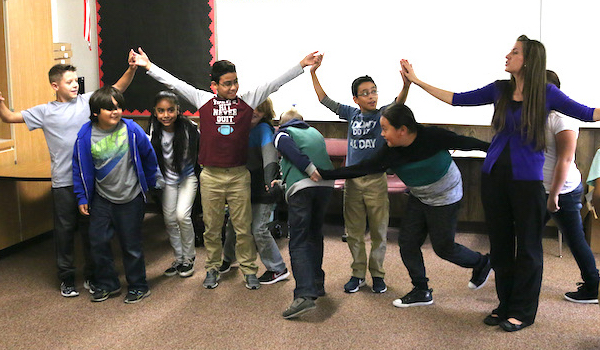
Lesson Summary
- Explore partitive and measurement division and the algorithm for long division.
- Identify the musical form of "Old Joe Clark."
- Sing in a round.
Lesson Plan and Procedure
Lesson Key Facts
- Grade(s): 4, 5
- Subject(s): Math, Music
- Duration of lesson: Three sessions, 30-45 minutes each
- Author(s): Emily Soderborg
Note: Play the recording of “Old Joe Clark” from the USBE website for students on multiple occasions to get them familiar with the song before teaching this lesson.
Activity 1: “Old Joe Clark” Singing Game
Sing and play the original version of “Old Joe Clark.”
Teacher: As I sing, please make a standing circle. Feel free to sing as well. Make windows with the people on either side of you by lifting your hands—palms out—and touching your neighbors' hands with enough space that I can walk through (or underneath) each window.
Teacher: Listen carefully as we play the game. Every time we sing a certain word, we are going to add another person to the end, creating a chain. See if you can hear what word we sing when we add on to our chain.
Begin singing and weave in and out through the windows until the word "go" in the song is reached. At this point, take the hand of the nearest person and continue through the windows.
The first time through the game, you (the teacher) model, helping the class know who is being added on to the chain and when they are being added. When the class figures out that they are listening for the word "go" in the song, the teacher has the person at the end of the line take the hand of the person nearest him or her to add to the chain. The longer the line gets, the slower the leader will need to go so the entire chain can keep weaving in and out of the windows.
Repeat the song until everyone is in one long line. The leader then leads the line into a spiral, where he or she is in the center, and then the leader turns the other direction and leads everyone back out again. The game ends when everyone is once again in a standing circle.
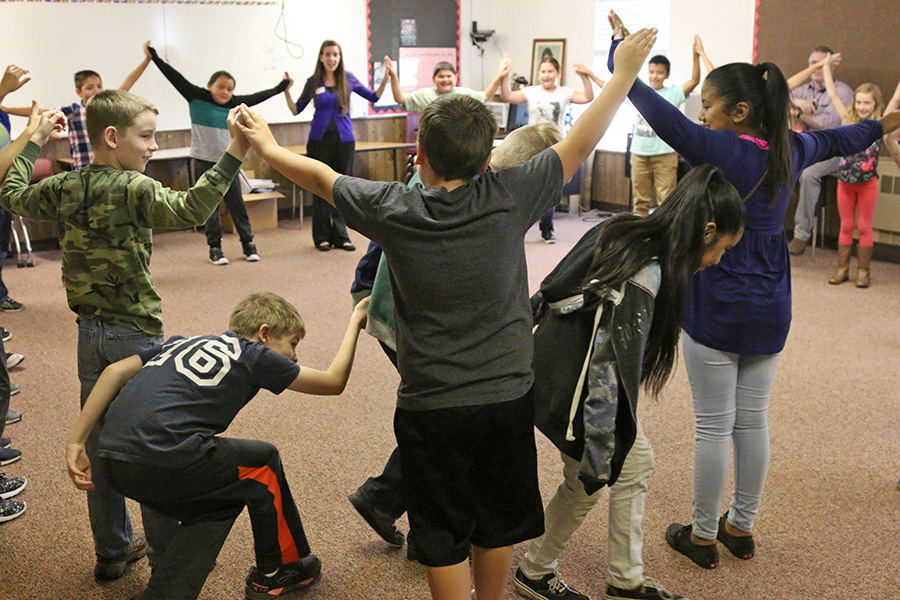
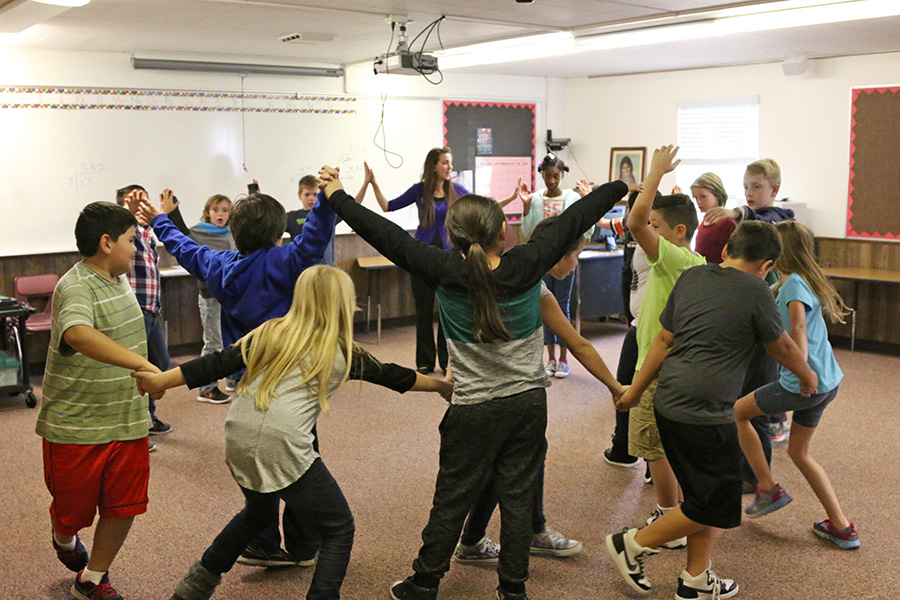
Measurement Division Game
Teacher: We're going to change the way we play the game just a little bit. We'll start the game the same way; however, in the chorus, I am going to change the lyrics and ask you to get into a group that has a certain number of people in it. Sit down immediately when you have the correct number in your group. If you don’t have a group, come stand by me.
See “Old Joe Clark” division variants sheet music in the Equipment and Materials Needed section.
Group students with the people nearest them. The teacher can sing any number, but it works best to start with smaller numbers. If someone is not in a group by the second time singing “make a group of seven,” he or she should stand near the teacher to see who else does not have a group, and then make a group. If any students cannot make a complete group, those students stand as individuals while the class sings, “How many remainders last?”
Teacher: We just did a division problem. Help me figure out what this problem is.
On the board, write how many people are in class today, including yourself (dividend). Write the number you said needed to be in each group (divisor). Count the number of groups sitting on the floor and write that number (quotient). Finally, count the number of people still standing and write that number (remainder). Ask a student to take the numbers and write them into a division problem on the board. Read the division problem aloud to the class. Remind the students of division vocabulary.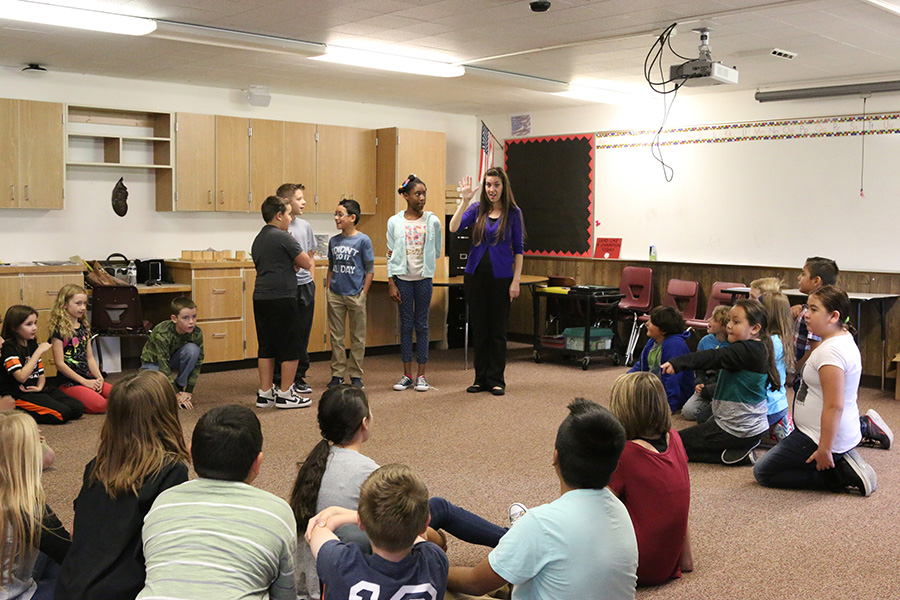
Teacher: When you make groups with a certain number in the group, this is called measurement division. It's like taking a measuring cup and scooping out the number you need for each group. Let’s try it again.
Select a new student leader who can go slowly through the windows. Sing another number for students to create groups using measurement division. As soon as the students figure out the number of groups created and the remainder(s), have them move back to a circle and pick up where they left off with the students that were in the line weaving in and out of the circle for the verse. Play one or two times more.
Partitive Division Game
Teacher: I'm going to change the chorus again. Listen carefully and follow the new instructions I sing.
Instead of singing, “Make a group of [three],” the teacher will sing, “Come together in [three] groups.” Let the students figure out how they are going to follow these new instructions.
Teacher: What did you notice when I asked you to make [three] groups? Was it easier for you to make a group with a certain number in it, or was it easier for you to make a certain number of groups?
Have students give reasons for their answers.
Teacher: When I ask you to make a certain number of groups, this is called partitive division. This is like dealing cards in a game. You put one in each group until you don’t have enough to evenly put any more into a group.
Briefly discuss partitive versus measurement division and when we use each.
Division Vocabulary Verse
Review math vocabulary by teaching the division vocabulary verse of “Old Joe Clark”:
“Whole group is the dividend,
“Divisor’s how we divide,
“Quotient is the answer,
“Remainder’s what’s left aside.”
Write down the division problems the students solved as they made different groups in the game. Sing the vocabulary verse as you solve the problems to label each part of the division problems. Play the division version of the game a few more times, interchanging measurement and partitive division—“make groups of [number]” and “come together in [number] groups.”
Assessment
- Students will have completed several measurement and partitive division problems.
- Students will be able to use math vocabulary correctly.
- Students will sing “Old Joe Clark” in tune, with good vocal tone and clear diction.
Activity 2: Musical Form Becomes Division
Play the division version of the game a few times to review the song. During the final time singing and playing the game, ask students to listen for the pattern or form in the song (verse, chorus, verse, or ABA). If necessary, have them listen to the recording so they can focus solely on listening.
Teacher: Did you hear how the first section is different than the second section, and then it goes back to the first section again? The first section we heard we're going to label “A.” The second section we'll label “B.” And because it returns to the first section again, we'll label the last section “A” again. This is called ABA form.
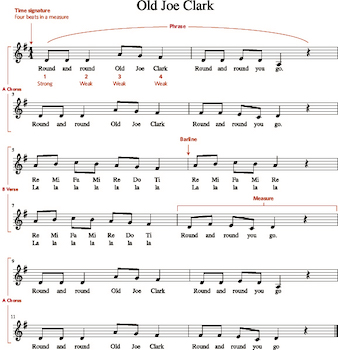
Sing through the song and have the students tap their bodies. They should tap the strong beat on one part of their body and tap the weak beat(s) on a different part. Lap / shoulders or head / snapping fingers are two examples of what students could do, but students can select their own. Have students tell you the strong / weak pattern they discovered.
The strong / weak pattern they feel tells the time signature. The pattern for this song is strong / weak / weak / weak, or four beats in a measure. There are 12 measures in the whole song. The A section has four measures, the B section has four measures and the A section again has four measures, totaling 12 measures.
Teacher: The time signature gives us even smaller divisions of the song. Remember, each pattern starting with a strong beat is called a measure. How many measures is the song divided into? Let’s sing in a round starting at the measures in the individual phrases. How many groups would we divide into if we had a group start at each measure?
Singing with different groups starting at each measure is a challenging exercise. Let the students try in small groups starting at each measure and see how they do. The more groups singing, the harder it is to keep the round going successfully. Then the students could try just two groups, but have the second group start one measure after the first group.
If they want to continue trying smaller increments, they could try singing a round starting at every two beats, or even at every beat. If they do not succeed, it is okay—the process of trying to see if it will work helps them learn what makes a round successful.
Help students see that there are division problems all around us all the time.
Teacher: Can you think of any other naturally occurring division problems?
Give them time to think, and then discuss their responses.
Assessment
- Students will sing “Old Joe Clark” in tune, with good vocal tone and clear diction.
- Students will be able to sing one part, while others around them sing a different part.
- Students will label the form of “Old Joe Clark” as ABA form.
Activity 3: Long Division Algorithm
Teacher: Today, you're going to be doing division problems with even larger dividends and divisors.
Play the division version of the game several times to review the song. However, instead of the dividend being the total number of students in class today, have students represent the dividend using different body parts, such as arms and legs.
In the example of arms and legs, each student would actually represent four instead of one. This will make your dividend much larger, making it a harder problem to solve. Make sure when you sing and get in groups that the number you select is a multiple of the number of body parts you are using, so whole individuals still make up the groups.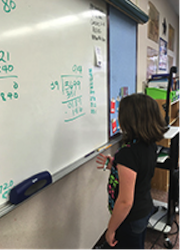
Write out a multi-digit division problem on the board to solve together. Teach students the algorithm division chorus of “Old Joe Clark” to help them learn and remember the steps for long division:
“To divide, we multiply,
“Subtract, and double check,
“Regroup to the next column,
“See if any remainder’s left.”
Practice a few problems as a group. Sing the steps to help remind students what to do next as they solve the long division problems using the algorithm. Include individual practice as time permits.
Sing through the entire division vocabulary verse and algorithm chorus. Play the singing game again as time allows.
Assessment
- Students will know the steps to follow when doing long division.
Learning Objectives
- Understand the difference between partitive and measurement division.
- Find whole-number quotients with possible remainders of whole numbers, with up to four-digit dividends and two-digit divisors.
- Sing in a multi-part round.
- Identify song form as ABA.
- Identify the time signature, measures, and phrases within a song.
- Connect to other subjects through the musical experience.
Utah State Board of Education Standards
This lesson can be used to meet standards in many grades and subject areas. We will highlight one grade’s standards to give an example of application.
Grade 4 Math
- Standard 4.MP.1: Make sense of problems and persevere in solving them. Explain the meaning of a problem, look for entry points to begin work on the problem, and plan and choose a solution pathway. When a solution pathway does not make sense, look for another pathway that does. Explain connections between various solution strategies and representations. Upon finding a solution, look back at the problem to determine whether the solution is reasonable and accurate, often checking answers to problems using a different method or approach.
- Standard 4.MP.2: Reason abstractly and quantitatively. Make sense of quantities and their relationships in problem situations. Contextualize quantities and operations by using images or stories. Decontextualize a given situation and represent it symbolically. Interpret symbols as having meaning, not just as directions to carry out a procedure. Know and flexibly use different properties of operations, numbers, and geometric objects.
- Standard 4.MP.3: Construct viable arguments and critique the reasoning of others. Use stated assumptions, definitions, and previously established results to construct arguments. Explain and justify the mathematical reasoning underlying a strategy, solution, or conjecture by using concrete referents such as objects, drawings, diagrams, and actions. Listen to or read the arguments of others, decide whether they make sense, ask useful questions to clarify or improve the arguments, and build on those arguments.
- Standard 4.MP.4: Model with mathematics. Identify the mathematical elements of a situation and create a mathematical model that shows the relationships among them. Identify important quantities in a contextual situation, use mathematical models to show the relationships of those quantities, analyze the relationships, and draw conclusions. Models may be verbal, contextual, visual, symbolic, or physical.
- Standard 4.MP.5: Use appropriate tools strategically. Consider the tools that are available when solving a mathematical problem, whether in a real-world or mathematical context. Choose tools that are relevant and useful to the problem at hand, such as drawings, diagrams, technologies, and physical objects and tools, as well as mathematical tools such as estimation or a particular strategy or algorithm.
- Standard 4.MP.6: Attend to precision. Communicate precisely to others by crafting careful explanations that communicate mathematical reasoning by referring specifically to each important mathematical element, describing the relationships among them, and connecting their words clearly to representations. Calculate accurately and efficiently, and use clear and concise notation to record work.
- Standard 4.MP.7: Look for and make use of structure. Recognize and apply the structures of mathematics such as patterns, place value, the properties of operations, or the flexibility of numbers. See complicated things as single objects or as being composed of several objects.
- Standard 4.MP.8: Look for and express regularity in repeated reasoning. Notice repetitions in mathematics when solving multiple related problems. Use observations and reasoning to find shortcuts or generalizations. Evaluate the reasonableness of intermediate results.
- Standard 4.OA.3: Solve multi-step word problems posed with whole numbers and having whole-number answers using the four operations, including problems in which remainders must be interpreted.
- Standard 4.NBT.6: Find whole-number quotients of whole numbers with up to four-digit dividends and two-digit divisors, using strategies based on place value, the properties of operations, and the relationship between multiplication and division. Illustrate and explain the calculation by using equations, rectangular arrays, and area models.
Grade 4 Music
- Standard 4.M.P.4: Sing folk, traditional, and rounds in tune, with good vocal tone and clear diction.
- Standard 4.M.P.6: Perform two- and three-part pentatonic rounds, partner songs and rhythmic or pentatonic ostinatos.
- Standard 4.M.R.2: Recognize form, meter, beat versus rhythm, timbre, mood, dynamics, tempo, melody, texture and harmony/tonality.
- Standard 4.M.R.6: Explore/express feelings conveyed by a music selection through movement or drawing.
- Standard 4.M.CO.2: Draw upon interests, knowledge, and skills developed to inspire and inform the creation, performance, and appreciation of music, and deepen understanding of another content area through music.
Equipment and Materials Needed
- "Old Joe Clark" recording
- "Old Joe Clark" original sheet music (PDF)
- "Old Joe Clark" division variants sheet music (PDF)
- "Old Joe Clark" song analysis (JPG)
- Whiteboard, marker, and eraser
- Paper and pencils
Additional Resources
Add rhythmic ostinatos on instruments. Discuss subdivision of the beat, which means breaking down the beat into even smaller groupings.
Ideas for singing, playing, creating, and listening: https://emedia.uen.org/browse?batch_size=20&sort_by=title&view_mode=summary&f.general_subject=music
The history of “Old Joe Clark” ties into fourth-grade social studies curriculum or fifth-grade American history. (See the following webpages for information.)
http://wmeamusic.org/files/2016/03/CMPtp2011_GenMus_OldJoeClark-Bartling.pdf (Wisconsin Music Educators Association—History)
http://www.mtnlaurel.com/mountain-music/1452-old-joe-clark.html (History)
https://www.musick8.com/html/ideadisplay.php?ibid=1834 (Square Dance Movements)
Look at different variations of the song and the different lyrics. Talk about how it was appropriate to make up new “division” lyrics for this song because the original intent of the song was to improvise lyrics. Have students improvise new lyrics using ideas from this website: https://voices.pitt.edu/LessonPlans.htm
Image References
Images 1–4: James Huston.
Images 5–6: Curtis and Emily Soderborg.

www.education.byu.edu/arts/lessons
 Download
Download